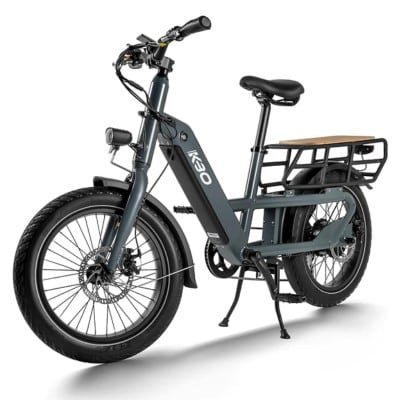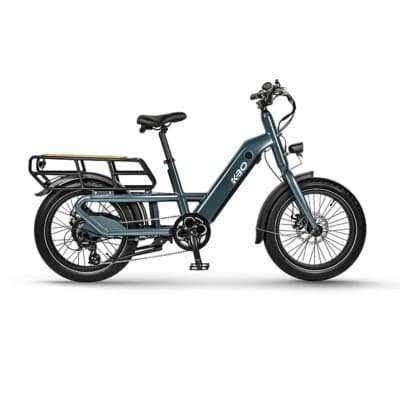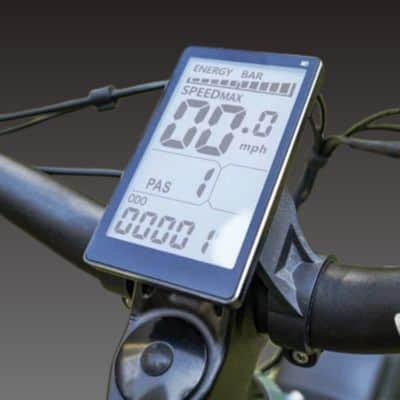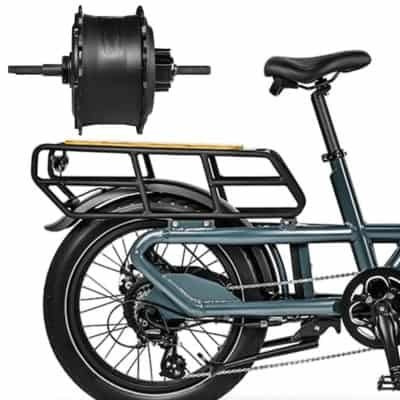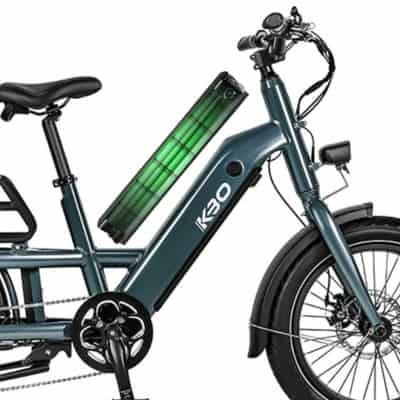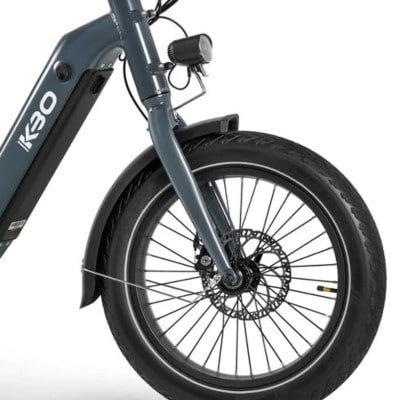Cargo bikes are becoming increasingly popular due to their ability to carry heavy loads and provide a more eco-friendly transportation option. Two popular cargo eBikes on the market are the RadWagon 4 and the KBO Ranger. In this article, we will compare these two bikes and help you decide which one is the best fit for your needs.
The RadWagon 4 is a well-known name in the world of cargo eBikes, and for good reason. It boasts a 750W motor, a 45-mile range, and a 350-pound carrying capacity. The bike also comes with a number of useful features such as a rear rack, adjustable kickstand, and LED lights. On the other hand, the KBO Ranger is a newer player in the market, but it offers some impressive features at a lower price point. The Ranger has a 750W motor, a 60-mile range, and a 400-pound carrying capacity. It also has a sleek design and comes with a number of accessories such as fenders and a rear rack.
Both the RadWagon 4 and KBO Ranger have their own unique strengths and weaknesses, and we will dive deeper into each of these bikes to help you make an informed decision. Whether you are a daily commuter or a weekend adventurer, choosing the right eBike can make all the difference in your experience. So, let's take a closer look at the RadWagon 4 and KBO Ranger to see which one comes out on top.
VS
Appearance & Design
The RadWagon 4 has a classic cargo bike look with a sleek and modern twist. It has a sturdy frame and comes in three different colors: black, white, and orange. The KBO Ranger, on the other hand, has an almost similar frame design but is available in only two colors; grey and orange.
In terms of size, the RadWagon 4 is larger and longer than the KBO Ranger, which makes it a better choice for those who need to carry larger loads. The Ranger, on the other hand, is more compact and easier to maneuver, making it a great choice for city dwellers who need a bike that can easily navigate through traffic and tight spaces.
Both bikes come with a variety of features that make them stand out. The RadWagon 4 has an adjustable handlebar stem that allows riders to customize their riding position, as well as an integrated LED taillight for added safety. The KBO Ranger, on the other hand, has a built-in LCD display that shows riders their speed, distance, and battery life.
Overall, both the RadWagon 4 and KBO Ranger have sleek and modern designs that are sure to turn heads. While the RadWagon 4 is larger and better suited for carrying larger loads, the KBO Ranger is more compact and easier to maneuver, making it a great choice for city dwellers.
Display and Controls
When it comes to the display and controls, both the RadWagon 4 and KBO Ranger have user-friendly interfaces that are easy to navigate. However, there are some differences between the two.
The RadWagon 4 features a backlit LCD display that is mounted on the handlebars. The display shows speed, distance, battery level, and pedal assist level. It also has a USB port for charging your phone or other devices on the go. The controls are located on the left side of the handlebars and include a power button, & plus and minus buttons for adjusting pedal assist level.
On the other hand, the KBO Ranger features a LCD display that is also mounted on the handlebars. The display shows speed, distance, battery level, pedal assist level, and has a built-in odometer. The controls are located on the left side of the handlebars and include a power button, & plus and minus buttons for adjusting pedal assist level.
One key difference between the two displays is that the KBO Ranger's display is larger and easier to read in bright sunlight.
Overall, both displays and controls are user-friendly and easy to use. However, the KBO Ranger's larger display give it a slight advantage over the RadWagon 4.
Weight and Weight Limits
Both the RadWagon 4 and the KBO Ranger are heavy bikes, but they are designed to carry heavy loads.
The RadWagon 4 has a total weight of 76.7 lbs, while the KBO Ranger weighs 77 lbs. The RadWagon 4 has a payload capacity of 350 lbs while the KBO Ranger can support up to 400 lbs of weight.
In our experience, we found that the weight limit of both bikes is accurate. We were able to load up the cargo area with groceries, a child seat, and additional gear without any issues. However, we recommend checking the weight limit before loading up the bike to avoid any accidents or damage to the bike.
It's also worth noting that the weight of the bike itself can affect the performance of the eBike. The heavier the bike, the more power will be required to move it. This can affect the range of the battery and the overall speed of the bike.
Overall, both the RadWagon 4 and the KBO Ranger are heavy-duty cargo eBikes that can handle heavy loads. However, if you're looking to carry a little extra load, the KBO Ranger might be the best option for you as it is built to carry heavier loads than the RadWagon 4.
Motor & Power
The KBO Ranger comes equipped with a 750W motor, while the RadWagon 4 has a 750W motor as well. The RadWagon 4 has a top speed of 20mph while the KBO Ranger can reach speeds of up to 28mph in pedal-assist mode.
One key difference between the two bikes is their battery life. The KBO Ranger has a 48V 17.5Ah battery, which provides a range of up to 60 miles on a single charge. The RadWagon 4, on the other hand, has a 48V 14Ah battery, which provides a range of up to 45 miles on a single charge. While the KBO Ranger has a slightly larger battery, it's worth noting that the RadWagon 4 has a more efficient motor, which may help to offset the difference in battery life.
Another important factor to consider is the level of assistance provided by the motor. The RadWagon 4 and the KBO Ranger come with five levels of pedal assist. Both bikes also have a throttle, which allows you to control the motor without pedaling. We found that both bikes provide a smooth and responsive ride, with plenty of power to tackle hills and headwinds.
Overall, we found that both the KBO Ranger and RadWagon 4 offer excellent motor and power performance. While the KBO Ranger has a slightly larger battery, the RadWagon 4 has a more efficient motor, which may help to offset the difference in battery life. Ultimately, the choice between these two bikes will depend on your specific needs and preferences.
Battery Capacity and Range
In this section, we will compare the battery capacity and range of the RadWagon 4 and the KBO Ranger.
The RadWagon 4 is equipped with a 48V, 14 Ah (672 Wh) battery, which provides an estimated range of up to 45 miles per charge. On the other hand, the KBO Ranger comes with a 48V, 17.5 Ah (840 Wh) battery, which provides an estimated range of up to 60 miles per charge. As we can see, the KBO Ranger has a larger battery capacity and offers longer range than the RadWagon 4.
However, it's important to note that the range of an eBike can vary depending on various factors such as terrain, rider weight, pedal assist level, and weather conditions. We recommend taking these factors into consideration when estimating the range of your eBike.
Both the RadWagon 4 and the KBO Ranger come with a variety of pedal assist levels, which can help to conserve battery life and extend your range. Additionally, both eBikes offer a throttle mode, which allows you to ride without pedaling at all.
In terms of charging time, the RadWagon 4 and the KBO Ranger both take approximately 6 hours to fully charge their batteries. This is fairly standard for most eBikes on the market.
Overall, the KBO Ranger offers a slightly larger battery capacity and longer range than the RadWagon 4. However, both eBikes offer a decent range and come with various features to help conserve battery life.
Ride Quality & Handling
We found that the RadWagon 4 has a slightly smoother ride due to its larger 22-inch wheels, which help to smooth out bumps in the road. The KBO Ranger's 20-inch wheels, while still providing a comfortable ride, doesn't quite match the RadWagon 4 in terms of smoothness.
In terms of handling, both bikes are easy to maneuver and control, even when fully loaded with cargo. The RadWagon 4 has a slightly longer wheelbase, which can make it feel a bit more stable at higher speeds. However, the KBO Ranger's shorter wheelbase makes it a bit more nimble and easier to handle in tight spaces.
Overall, we found both the RadWagon 4 and KBO Ranger to be excellent choices in terms of ride quality and handling. While the RadWagon 4 may have a slight edge in terms of ride smoothness, the KBO Ranger's nimble handling make it a great choice for those who need to navigate tight spaces or want a bike that feels more balanced when fully loaded.
Brakes
Both the RadWagon 4 and the KBO Ranger are equipped with mechanical disc brakes, providing reliable stopping power for a safe riding experience. These mechanical disc brakes offer a notable advantage in various weather conditions, ensuring consistent braking performance whether you're cruising under the sun or navigating wet surfaces.
One noteworthy feature is that both bikes boast 180mm rotors. This larger rotor size contributes to enhanced braking efficiency by increasing the surface area for friction, resulting in more controlled deceleration. The use of 180mm rotors reflects the manufacturers' commitment to equipping these ebikes with brakes that can handle the demands of different terrains and riding styles.
Whether you're cruising downhill on a steep slope or navigating through urban traffic, the 180mm rotors on both the RadWagon 4 and the KBO Ranger provide ample stopping power to instill confidence in your riding experience.
VS
Suspension, Wheels & Tires
Both the RadWagon 4 and the KBO Ranger are equipped with rigid forks, providing a stable and reliable ride. The absence of suspension forks might result in a more direct connection with the road, making it important to consider the terrain you'll be riding on.
The RadWagon 4 boasts 22" x 3" tires, offering a larger tire size that could potentially enhance stability and traction. On the other hand, the KBO Ranger features 20" x 3" tires, which might provide slightly more maneuverability and a lower center of gravity.
While the RadWagon 4's larger tires could excel on rougher terrains, the KBO Ranger's slightly smaller tires might cater to urban environments with more agility. Assessing your preferred riding conditions will help you decide which tire size is better suited to your needs.
Remember to consider factors such as comfort, traction, and the type of terrain you'll encounter most frequently when evaluating the differences in suspension, wheels, and tires between these two ebikes.
Pedal Assist & Throttles
There are two main types of electric assist systems: pedal assist and throttle. Both the RadWagon 4 and KBO Ranger offer both options, so let's take a closer look at what each one does.
Pedal Assist
Pedal assist, also known as pedal-assisted system (PAS), is a system that provides electric assistance while you are pedaling. The amount of assistance provided depends on the level of assistance you choose, which is usually controlled by a button or display on the handlebars. The higher the level, the more assistance you get, and the easier it is to pedal.
Both the RadWagon 4 and KBO Ranger offer a pedal assist system with multiple levels of assistance to choose from. The RadWagon 4 has five levels of pedal assist, while the KBO Ranger also has five levels. We found that the pedal assist on both bikes was smooth and responsive, making it easy to get up to speed quickly and climb hills with ease.
Throttle
A throttle is a simple lever or button that provides electric assistance without the need to pedal. This can be useful if you need a quick boost of power, or if you want to take a break from pedaling for a moment. However, keep in mind that using the throttle exclusively will drain your battery faster than using the pedal assist system.
Both the RadWagon 4 and KBO Ranger offer a throttle option, which can be useful in certain situations. We found that the throttle on both bikes was easy to use and provided a quick burst of power when needed.
Which is Better?
Both pedal assist and throttle have their pros and cons, and which one you choose will depend on your personal preferences and riding style. If you want a more natural riding experience and want to get some exercise while you ride, then pedal assist is the way to go. If you want a quick burst of power or need to take a break from pedaling, then a throttle can be useful.
Overall, we found that both the RadWagon 4 and KBO Ranger offer excellent pedal assist and throttle options, making them both great choices for anyone looking for an eBike.
Accessories
Beyond their impressive features, both e-bikes offer a range of accessories that cater to diverse preferences and needs. Let's explore how these complementary add-ons enhance the biking experience and make each ride uniquely tailored to the rider's lifestyle.
RadWagon 4 Accessories
The RadWagon 4 is known for its versatility, and its accessories reflect that. Here are some of the most notable accessories that can be added to the RadWagon 4 and some that come with the bike:
KBO Ranger Accessories
The KBO Ranger is a newer eBike, but it still has a lot to offer when it comes to accessories. Here are some of the most notable accessories that can be added or come with the KBO Ranger:
Overall, both the RadWagon 4 and KBO Ranger have a lot to offer when it comes to accessories. It really comes down to what you need and how you plan on using your eBike.
Portability
The RadWagon 4 weighs 76.7 pounds, while the KBO Ranger weighs 77 pounds. In terms of size, the RadWagon 4 boasts a length of 78.7 inches and a handlebar length of 27.5 inches, with a handlebar height of 47.2 inches. On the other hand, the KBO Ranger features a length of 69 inches and a handlebar length of 28.3 inches, with a taller handlebar height of 53 inches.
These specifications indicate that the RadWagon 4 is slightly lighter than the KBO Ranger, but it offers a longer frame and lower handlebar height, potentially affecting its overall ease of transport and storage. The KBO Ranger, with its shorter length and taller handlebar, may have advantages in certain scenarios that require more compact dimensions. By considering these factors, riders can make an informed choice based on their specific portability needs.
Water Resistance
We all know that weather can be unpredictable, and it's important to have a bike that can withstand the elements.
Both the RadWagon 4 and the KBO Ranger are designed to withstand light rainy conditions, ensuring you can continue your journey even if the weather takes an unexpected turn. While specific water resistance ratings are not provided by the manufacturers, both bikes are engineered with sufficient sealing to keep the internal components protected from light moisture exposure.
It's important to note that both bikes are not intended for heavy rain or submersion in water. The manufacturers recommend avoiding riding in heavy downpours or fully immersing the bikes in water, as this could compromise the internal components and lead to potential issues. While the bikes are sealed to provide a level of protection against light rain, it's advised to exercise caution and prioritize their longevity by not exposing them to extreme wet conditions.
In conclusion, both the RadWagon 4 and the KBO Ranger offer a degree of water resistance suitable for light rainy conditions, allowing you to confidently navigate through unexpected drizzles. However, riders should adhere to the manufacturers' guidelines and avoid subjecting the bikes to heavy rain or submersion in water to ensure their continued performance and longevity.
Value for the Money
When considering the RadWagon 4, its price range of $1599 to $1999 reflects its versatility and features. With the potential for promotional pricing at $1599, the RadWagon 4 becomes an even more compelling option. This e-bike offers a blend of functionality, including its carrying capacity and performance, which can make it a worthwhile investment for those seeking a reliable and capable electric bike.
In comparison, the KBO Ranger's pricing falls between $1599 and $1799, positioning it as an accessible choice for those looking for a balance between cost and performance. The KBO Ranger's features and build quality in this price range provide solid value, especially for riders who prioritize a seamless riding experience without compromising on features.
By comparing the price ranges and benefits of the RadWagon 4 and the KBO Ranger, readers can make an informed decision based on their budget and preferences, ensuring they get the most value for their investment in an electric bike.
Pros vs Cons RadWagon 4 & KBO Ranger
Here's a rundown of the pros and cons of the RadWagon 4 and the KBO Ranger:
Pros of RadWagon 4
Cons of RadWagon 4
Pros of KBO Ranger
Cons of KBO Ranger
Overall, both the RadWagon 4 and the KBO Ranger have their pros and cons. Which one is right for you will depend on your specific needs and budget.
Specifications and Features Table
Below is a table that breaks down some of the key differences between the two bikes:
Specification/Feature | RadWagon 4 | KBO Ranger |
|---|---|---|
Price | Between $1599 and $1999 | Between $1599 and $1799 |
Battery Life | Up to 45 miles per charge | Up to 60 miles per charge |
Weight Capacity | 350 lbs | 400 lbs |
Motor | 750W | 750W |
Frame Material | Aluminum | Aluminum |
Wheel Size | 22″ | 20″ |
Brakes | Tektro 180mm front and rear disc brakes | Tektro 180mm front and rear disc brakes |
Gears | Shimano 7-speed | Shimano 7-speed |
Lights | Front and rear LED lights | Front and rear LED lights |
Display | LCD with speedometer, odometer, trip odometer, battery level, and pedal assist level | LCD with speedometer, odometer, trip odometer, battery level, and pedal assist level |
As you can see, the RadWagon 4 is slightly more expensive than the KBO Ranger. The RadWagon 4 also has larger wheels, which can make it more stable and comfortable to ride over bumps and rough terrain.
Both bikes have the same motor and similar brakes, gears, and lights. The LCD displays on both bikes are also very similar, showing speed, distance, battery level, and pedal assist level.
One key difference between the two bikes is their frame material. The RadWagon 4 has an aluminum frame, which is lightweight and durable. The KBO Ranger also has an aluminum frame, but it has some smaller dimensions than the RadWagon 4.
Overall, both the RadWagon 4 and the KBO Ranger are high-quality cargo eBikes that offer a lot of value for their price. Which one you choose will depend on your specific needs and preferences, but hopefully this table has helped you compare the two bikes and make an informed decision.
Overall Recommendation Based on Intended Use
Both bikes have their strengths and weaknesses, and ultimately, the best choice will depend on your specific needs.
If you're looking for a cargo bike that can haul heavy loads and navigate hilly terrain with ease, the KBO Ranger is an excellent choice. With its powerful motor and large cargo capacity, this bike is perfect for families or anyone who needs to transport large items. However, if you're looking for a more reliable option that still offers plenty of features, the KBO Ranger is a great alternative.
One thing to keep in mind is that the KBO Ranger is a bit heavier than the RadWagon 4, which can make it more difficult to maneuver in tight spaces. Additionally, the KBO Ranger has a slightly longer battery life, which may be important if you plan to use your bike for longer trips.
Overall, we recommend the KBO Ranger for anyone who needs a heavy-duty cargo bike that can handle tough terrain and large loads. However, if you're in the market for a trusted ebike or don't need quite as much cargo capacity, the RadWagon 4 is an excellent alternative that still offers plenty of great features.
VS


